Resumania is a resume-building tool. It’s aimed at making it easy to compose multiple resumes without having to rewrite a lot of duplicate information.
Template
This is what the template looks like without modification:

Quick Start
If you just want a quick copy-paste-modify start:
#import "@preview/resumania:1.0.0": *
// Define parts of the resume using Resumania's "types" (see below)
#let author = "Your Name"
#let contacts = contact-section(
phone("+0 (123) 555-0100"),
email("you@example.com"),
linkedin: url-link(name: "LinkedIn", "example", "https://linkedin.com"),
github: url-link(name: "GitHub", "example", "https://github.com"),
portfolio: url-link(name: "Portfolio", "you.com", "https://example.com/you"),
location: location[Your location],
)
#let educations = education-section(
education(
institution: "Name of School",
location: "Location of school",
kind: "Degree",
study: "Area of study",
timeframe: datetime.today(),
score: "x",
scale: "y",
),
)
#let works = work-section(
work(
company: "Company name",
location: "Location of work",
position: "Position at company",
timeframe: (
start: datetime.today(),
end: "Present",
)
)[Description of work done.],
)
#let projects = project-section(
project(title: "Project title", timeframe: "Project date")[
Project ddescription.
],
)
#let skills = skills-section(
skillset("Skill 1", "Skill 2"),
skillset("Skill 3", "Skill 4"),
)
#show: resume.with(
author,
sections: (contacts, educations, works, projects, skills),
)
Concepts
Since Typst doesn’t yet have custom types, Resumania
uses dictionaries as a substitute, with convenience “constructors” provided
for each one.
Similarly, since types aren’t built-in, there are no show/set rules that can
be used with Resumania’s types.
To get around this, Resumania exposes functions that create Typst dictionaries
to later be turned into content using Resumania show-* functions, of which
the most-used is show-section.
Resume sections and elements
Resumania categorizes its types into two kinds: (1) sections and (2) section elements.
There are 5 Resumania sections: work, education, projects, skills, and contact
information.
Every one of these can be turned into content using show-section.
For each of the sections, there is a corresponding element (or multiple in the
case of contacts).
Each element has a function to create it except for skills, which can be
anything that can be trivially turned into content.
The functions are work, education, project, and contact.
Contacts are a special case for elements that have “sub-types”, namely phone,
email, url-link, and location, which are conveniences since contact
requires a function that converts it into content.
This general structure should allow plenty of flexibility for defining custom resume sections if desired.
Styling
Resumania doesn’t provide a significant amount of specific styling optionality, but it does have a styling system that’s flexible enough to do just about anything you desire, provided you have the will to put in the effort.
Basically, you can write the styling for any component in the resume, and even custom “show” rules (see below).
“Show” Rules
Since Typst doesn’t yet have custom types, there isn’t actually a way to write
real show rules.
The workaround is basically to define a state that tracks the “current”
function that acts as a show rule of sorts (“current” is in quotes because
the definition really depends on layout order, which acts a bit differently
than traditional programming language execution order).
For Resumania, these are all located in the style module through the
current-style state.
The styling takes effect whenever show-section or a specific section element’s
show function gets called.
If you wish to edit the style, look in the style module for default-style as
an example.
Here are all of the styleable keys:
name: the name appearing at the top of the resumesection: section titleselement: element titles within sectionstimeframe: timeframes (part of section headers)location: locations (part of section headers)header: the entire header of an element, applied on top of theelement,location, andtimeframestylesbody: the entire body of an element
Each key in the style maps to a function which takes one argument of content
and returns content.
This means that, for example, if you just want to erase the styling you can set
the style key which you want to reset to text.
Miscellaneous Styling
There are a few small styling options not included in the style module that
are specific to certain sections.
These are contact-separator in the contact module, skill-separator in the
skill module, and default-datetime-format in the timeframe module.
Each of these is its own state and may be freely changed as you like.
For example, to change the contact separator to a space instead of the pipe character:
#contact-separator.update(h(1em))
or to set the skills separator to a pipe character instead of a comma:
#skill-separator.update([ | ])
Resume rules
Since Resumania resumes are composed typically by defining sections and then
finally ending the Typst document with a show: resume.with(...) call, there
may be some things you can’t easily style (or might get overridden by
Resumania defaults).
If you would like to change the main document’s show/set rules you can make
changes to the resume-rules state in the resume module.
This state is just a function that takes the author and resume body (which will
already be content).
It should mostly be used just for document setup such as page margins and text
font/size, but of course you’re free to do whatever you want.
There is no specific styling available past this because Resumania isn’t really meant to make super fancy-looking resumes (which are overrated/unnecessary in this author’s opinion).
It is highly recommended to use the default-rules as a basis for your own
rules.
As an example, if you wanted to change the font from Resumania’s default to a
monospace font:
#resume-rules.update(_ => { (author, body) => {
default-rules(author, text(font: "Liberation Mono", body))
}})
Local Installation
Resumania can be installed locally to be used offline. First, clone Resumania’s source.
Then, assuming you have fish and just installed,
you can run just install (probably only works for MacOS, Linux, and Windows,
but the .justfile should be fairly easy to edit for other platforms if
needed).
If you’re not on a supported platform, or you don’t have fish/just, you’ll
have to look at the recipe for building and installing in .justfile and
simply perform equivalent steps for your platform.

